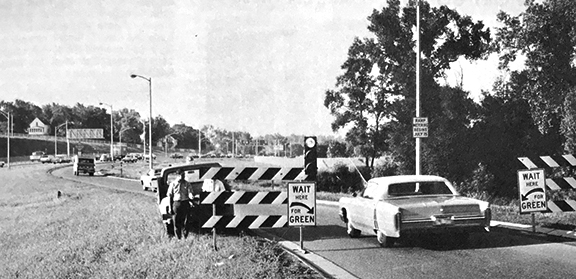By Joseph Palmersheim

This picture from the October 1969 issue of the Highway Department's "Minnesota Highways" newsletter shows what MnDOT's first freeway ramp meters looked like. The ramps were tested during a two-week window in the summer of 1969 on I-35E between County Road B and downtown St. Paul. File photo |
It’s a “pause” for celebration.
This summer marks the 50th anniversary of MnDOT’s first use of freeway ramp meters. The initial two-week test in 1969 deployed meters on southbound Interstate 35E at Maryland Avenue, Wheelock Parkway and Roselawn Avenue. Now, a half-century later, there are more than 460 freeway ramp meters throughout the Twin Cities metro area.
“MnDOT was an early adopter of this technology,” said Brian Kary, director of traffic operations at the Regional Transportation Management Center. “The first was Chicago in 1963. Los Angeles did it in 1967. We were one of the first cities out there that were doing it.”
Ramp meters serve an important function by relieving congestion on the freeway, Kary said. They reduce mainline congestion while ensuring wait times are no longer than four minutes per vehicle on local ramps and two minutes per vehicle on freeway-to-freeway ramps. While the first meters operated using timers, newer meters can respond to real-time conditions and operate only when needed. Metering rates will update every 30-seconds based on traffic data.
“Ramp metering intends to keep the mainline flowing at 45 mph or better,” Kary said. “People sometimes complain – ‘Why am I sitting here at the meter when there is no congestion?’ The reason there is no congestion is the metering is working. Metering improves the efficiency of the mainline by keeping traffic moving, which improves freeway capacity and reduces crashes.”
An article in the October 1969 issue of Minnesota Highways, the then-Highway Department’s employee newsletter, described the initial test carried out during peak morning-hour traffic. Traffic volumes and times on the section of freeway were recorded, along with those from three alternate routes for comparison. Aerial photographs from one of the Highway Department’s airplanes were also used.
“Preliminary analysis of the data confirms … that the quality of traffic flow had been improved during the metering operation,” according to the article.
Glen Carlson, who retired from MnDOT in 2003, served as the first director of the Traffic Management Center. He recalled that the first test timers were pre-timed by hand. The feedback for correction was as simple as adjusting the algorithm after seeing traffic stop three miles down the line from the ramp meter.
“The human brain was the computer on that first project,” he said.
MnDOT installed the first permanent ramp meters in October 1970 on southbound I-35E at Maryland and Wheelock, and on southbound I-35W at 31st and 36th streets in Minneapolis. The original Traffic Management Center opened in 1972 in downtown Minneapolis at the corner of 11th Street and 4th Avenue. These days, the Regional Transportation Management Center operates out of Water’s Edge in Roseville. The newer facility, shared by MnDOT and the Department of Public Safety, opened in 2003.
So what happens without meters? A bill passed by the Legislature in 2000 required MnDOT to do a shutdown study of the ramp meters for a six-week period. When meters shut down in in October 2000, freeway capacity decreased by 9 percent, travel times increased by 22 percent, freeway speeds dropped by 7 percent and crashes increased by 26 percent.
“Turning them off seemed to prove the point that they worked,” Carlson said.
MnDOT currently operates 461 ramp meters. Kary said the system “grew quite a bit” in the 1990s, going from around 100 meters in the 1980s to close to 400 by the end of the next decade.
“Now, only Los Angeles has more ramp meters than we do, with more than 1,000,” Kary said. “We were an early adopter of this technology, and we continue to be a leader.”
Carlson, who worked at MnDOT as a student worker in 1956 before joining full time in 1964, looks back on the ramps with satisfaction.
“I felt they’ve done a lot of good,” he said. “Studies showed we prevented a lot of crashes, and the freeways can carry a little higher volume.”
|



